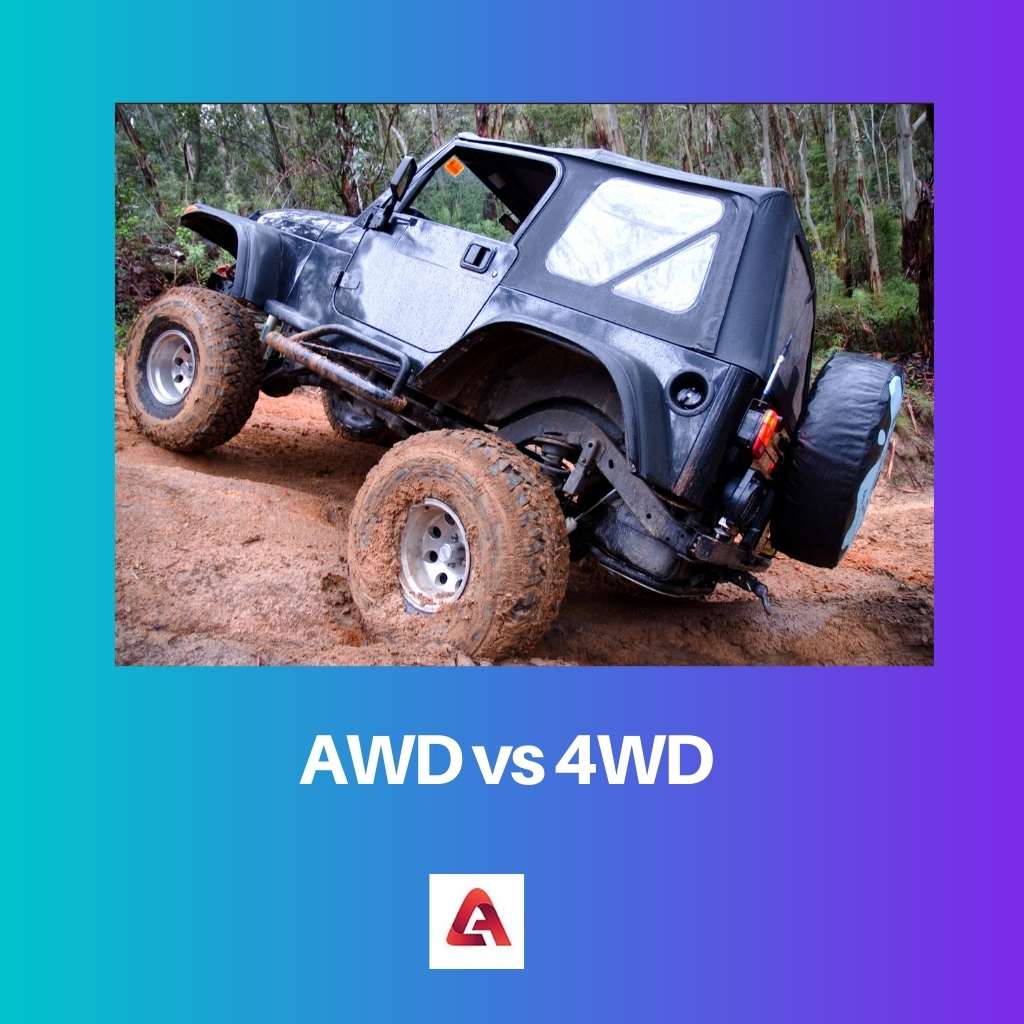Wheel drive of a vehicle can transmit force, which is essential for changing the torque into tractive energy. This force travels from the tire to the road,, so the car moves ahead.
Wheel drive can be broadly classified into two main types. The two types are – AWD and 4WD.
Key Takeaways
- AWD systems automatically provide power to all four wheels, adapting to various road conditions for improved traction.
- 4WD systems allow drivers to engage power to all four wheels manually, offering better off-road capabilities.
- AWD vehicles deliver better fuel efficiency than 4WD vehicles, making them more economical for everyday driving.
AWD vs 4WD
AWD systems are designed to automatically adjust power distribution between the front and rear wheels, while 4WD systems provide power equally to all four wheels. AWD delivers power to all four wheels, but not necessarily equally. 4WD provides power equally to all four wheels and is used for off-road or heavy-duty cars.

AWD has one axle, permanently connected with the drive, and the other only connected when needed. AWD is always on and operates automatically. The fuel economy of AWD vehicles is comparatively lower.
On the other hand, vehicles with 4WD have a two-axled drivetrain that can provide torque to all cars simultaneously. 4WD has to be manually switched by the driver and is not always on.
The fuel economy of 4WD vehicles is higher than AWD vehicles.
Comparison Table
| Parameters of Comparison | AWD | 4WD |
|---|---|---|
| Meaning | AWD stands for All-Wheel Drive system | 4WD stands for 4-Wheel Drive vehicle |
| Off-road efficiency | AWD works fine for occasional off-roading excursions | 4WD works fine for regular off-roading excursions and can even allow efficient driving in remote areas |
| Ideal users | AWD is ideal for riders of nasty weather and rough roads | 4WD is ideal for users who perform heavy hauls on the job site |
| Advantages | 4WD is ideal for off-roading conditions, which include mud or sand, offers more versatility in conditions that required switching between drive modes, has a beneficial value while selling | Higher upfront are more expensive than conventional 2WD, the components of AWD has extra weight which reduces fuel economy, braking distances are not affected by AWD |
| Disadvantages | The driver has to switch 4WD manually, Expensive models than traditional to AWD vehicles, vehicles with 4WD have less demand in the market, and requires high maintenance | The driver has to switch 4WD manually, Expensive models than traditional to AWD vehicles, vehicles with 4WD have less demand in the market and require high maintenance. |
What is AWD?
AWD stands for All-Wheel Drive. Vehicles with AWD have a powertrain which is the power provider to the car, which can be on-demand or full-time.
The on-demand type of AWD has one axle, permanently connected to the drive, and the other only connected when needed. While the full-time AWD has all the axles connected permanently and may or may not include a differential.
AWD may also be independent where the wheels are driven but does not depend on the central mechanical power coupling. All-wheel drive can be further divided into three main types.
They are – four-wheel drive or 4WD, six-wheel drive or 6WD, eight-wheel drive or 8WD. 4WD reflects two axles, 6WD reflects three axles and 8WD reflects four axles.
The use of a differential is in a good road where the tire grip is better. This helps the axles to avoid driveline windup.
It is not essential during off-roading as with limited grip also, the tire can slip faster All-Wheel Drive vehicles built for off-roading do not have a differential which makes them suffer from wind up when they are on-roading.
With the sophistication of vehicles, it was decided to give the benefits of All-Wheel Drive in conventional cars in 1960. It was not applied for off-roading and was limited for winter use in snow or wet roads.
The first high-speed road-based cars with All-Wheel Drive were Jensen FF, Subaru Leone, AMC Eagle, Audi Quattro, and others.

What is 4WD?
4WD stands for Four-Wheel Drive. It is also known as 4×4 or four-by-four. Vehicles with 4WD have a two-axled drivetrain that can simultaneously provide torque to all cars.
It can be on-demand or full-time type. The linking of 4WD is with a transfer case that caters to a different output drive shaft and can even provide gear ranges in some instances.
4WD is a type of AWD. 4WD has a set of particular functions and components designed for the off-roading application. 4WD has a compilation of everyday use of the terminology.
In the term four-by-four, the first figure signifies the total number of wheels, and the second figure signifies the number of axel ends being powered. The vehicles with 4WD are equipped with transfer cases.
The transfer case function in 4WD vehicles allows users to switch between the operating mode of 2WD or 4WD automatically or manually.
The current four-wheel drive usage is to light passenger vehicles and even heavy vehicles in North America.
4WD vehicles are coupled with anti-slip technology, which increases the hydraulic base and even allows the spinning of differentials at different speeds.
The application of 4WD is in vehicles used for road racing, construction equipment, or heavy trucks. The cars can operate not only in basic modes but also combine other types of modes.

Main Differences Between AWD and 4WD
- AWD can work automatically, while 4WD has to be switched manually by the driver.
- The safety of AWD is higher since the system can automatically send torque to the wheel. In comparison, the safety of 4WD is comparatively lower since the driver has to take action manually during an emergency.
- AWD is found in crossovers and regular cars, while 4WD is found in off-road vehicles like heavy trucks.
- AWD is not as robust as 4WD.
- AWD has no risk of axle binding while 4WD has the risk of axle binding and has to be turned off by the driver.

- https://www.tandfonline.com/doi/abs/10.1080/00423110801935830
- https://www.sae.org/publications/technical-papers/content/2006-01-0822/

The article offers a very comprehensive explanation about the different types of drive, their differences, advantages, and applications. The article provides a relatively good and detailed understanding of the AWD and 4WD systems.
This article really delves into the details of AWD and 4WD systems, offering a comprehensive understanding of their technical aspects, features, and operational differences.
The article presents an in-depth comparison of AWD and 4WD, providing great insights into the characteristics and applications of both systems.
I found the article to be very enlightening and the explanation about AWD and 4WD is clear and comprehensive. The detailed comparison of AWD and 4WD is very useful for anyone looking to understand which system best fits their needs.
This article is very helpful in understanding the distinction between AWD and 4WD systems, providing detailed explanations about their features, advantages, and potential downsides.
The article does a really great job explaining the differences and unique characteristics of AWD and 4WD in a very comprehensive manner.
The comparison table provided is an excellent resource for understanding the key differences between AWD and 4WD, this article definitely serves as an important reference for anyone interested in this topic.
The article about AWD and 4WD systems is very pedagogical and insightful, it provides a deep understanding of both systems, and it is very informative for anyone interested in knowing the operating principles of each and their differences.
The article was very informative, providing great details about AWD and 4WD systems, their operating principle, and key differences. It’s a valuable piece for anyone looking to expand their knowledge on this topic.
The information presented is valuable and is great for people who want to compare the advantages and disadvantages of AWD and 4WD.